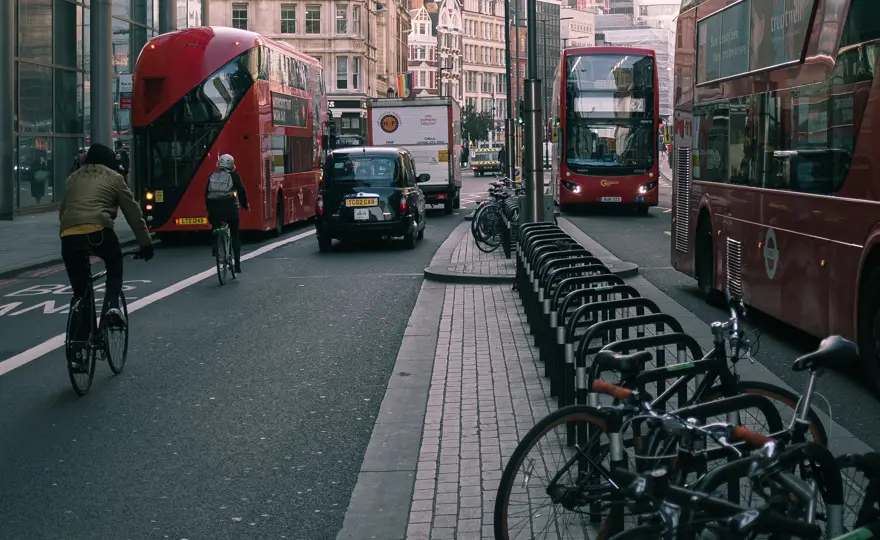ClientEarth Communications
29th November 2021


Air pollution is damaging people’s health, reducing their quality of life and cutting lives short.
This is true all over the world – but we are seeing the start of a long-awaited change in the UK.
In 2019, 75% of UK air quality reporting zones were still charting illegal levels of air pollution, when legal limits should have been met in 2010. But after more than a decade of inaction, our hearts and lungs have something to look forward to. Concrete measures to get that illegal air pollution down – Clean Air Zones (CAZs) – are increasingly becoming a reality across the UK.
Following ClientEarth’s three court wins against the UK Government, since 2017 ministers have ordered over 60 local authorities to come up with proposals to tackle the illegal levels of pollution in their areas. Many of those with the biggest problems have put CAZs at the core of these plans.
CAZs deter the most polluting vehicles from entering the most polluted parts of towns and cities by setting minimum emission standards – those vehicles that do not meet these standards are discouraged from entering the zone by otherwise having to pay a charge. The UK Government’s own research shows that they are the most effective way to quickly reduce illegal and harmful levels of air pollution in urban areas – in short, they protect people, and quickly.
We know they work in practice: recent statistics show that London’s Ultra Low Emission Zone (ULEZ) has reduced nitrogen dioxide pollution by up to 37% in the 3-month period before the first lockdown, compared to a scenario where no ULEZ was in place.
Nitrogen dioxide – mainly coming out of vehicle exhaust pipes – is the largest source of illegal air pollution in our towns and cities. Its levels have previously been up to double and even triple legal limits in many urban areas.
ClientEarth has always believed that the UK Government should introduce CAZs alongside help and support for people and businesses across the country to move to cleaner forms of transport as quickly as possible.
Bath
On 15 March 2021, Bath launched the first Clean Air Zone outside of London. It applies to all vehicle types that do not meet the minimum emissions standards except for private cars and motorcycles.
Sally Merrett, who lives in Bath, said:
I am really pleased that the Bath CAZ is coming into effect; it gives me hope that Bath will become an extremely attractive place to live, work and visit after many years of being blighted by air pollution.
Birmingham
Hot on Bath’s heels, Birmingham launched a CAZ affecting all vehicle types, including private vehicles, that do not meet minimum emission standards on 1 June 2021.
Portsmouth
The coastal city launched its CAZ on 29 November 2021. The CAZ applies to HGVs, buses, coaches and taxis.
Expansion in London
In March 2021, the capital tightened the emission standards for its city-wide Low Emission Zone, affecting buses, lorries, coaches and some larger vans, which has been in place since 2008. And crucially, the Ultra Low Emission Zone which launched in 2019 and applies to all vehicles including private cars and motorcycles, was expanded from the city centre to cover all of inner London, up to the North and South Circulars, on 25 October 2021.
Bristol
A CAZ that will affect all vehicles types was supposed to be introduced in October this year in Bristol – but has been pushed back yet again to summer 2022, after already being delayed several times. And recent briefings by the Council suggest this could be pushed back further.
Greater Manchester
After much delay, Greater Manchester will be launching its CAZ on 30 May 2022, almost three years after originally being directed by ministers to implement the scheme. The CAZ will apply to all vehicle types that do not meet the minimum emissions standards except for private cars and motorcycles though a number of exceptions and sunset clauses have been put in place that will delay the full effectiveness of the CAZ until 2023.
Bradford
Bradford Council was due to launch a CAZ in January 2022 but currently no date has been confirmed. Like Bath’s and Greater Manchester, it will apply to all vehicle types that do not meet the minimum emissions standards except for private cars and motorcycles.
You can check if your vehicle will be affected by any of the above CAZs at https://www.gov.uk/check-clean-air-zone-charge.
There are other major urban areas where CAZs are needed and may be launching soon. This includes Newcastle and Gateshead, Sheffield, Liverpool, and Stoke-on-Trent.
As more councils take action to tackle illegal air quality, the long-term benefits to public health and the economy will be huge and our cities will become better places to live.
However, this is not the end of the fight – we need to ensure that the UK government provides more help and support to people and businesses to move on to cleaner forms of transport and adopts stronger clean air laws to better protect people’s health.